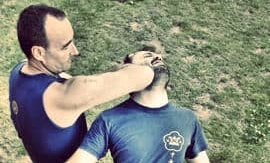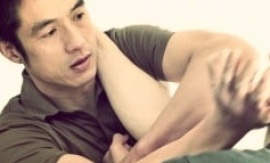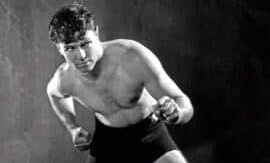
AARON VYVIAL STARTED IN VING TSUN AT THE AGE OF 17 AND BECAME A DISCIPLE OF MOY TUNG IN 1998. LATER, HE WAS INVITED TO BE A DISCIPLE UNDER MOY YAT AS A MEMBER OF HIS GSSA (GRAND SPECIAL STUDENT ASSOCIATION). HOWEVER, MOY YAT HAD A STROKE AND HE HAD TO POSTPONE THE BAI SI CEREMONY, NEVER MAKING IT IN THE END DUE TO MOY YAT’S PASSING.
When Aaron started his first school in 2002, he was given the honour of a Gung Fu family name, Moy Sup Tung, by his Sifu, who also left him with this advice: “Teach pure Ving Tsun from the heart.”
Tell me a little about yourself and how you got started in Ving Tsun.
I had previously been through the kid’s martial art process, but never really found anything interesting until I was invited to a Moy Yat Branch School run by Moy Tung in Richmond, Virginia. The thing that really drew me to the Moy Yat family was the nature of Moy Yat’s Gung Fu. Publicly, he was very quiet as he never really gave a true interview, nor did he ever make a lot of claims at being deadly or the best fighter. I wouldn’t say it was being humble—from my perspective, he was just very comfortable and sure of his knowledge of Gung Fu. He didn’t need to put himself out there because people came to him.
I try to run my classes in a very traditional manner, following the proverb: Ving Tsun Chuen Jing Tung, which can be translated as “Ving Tsun Authentically Passing Down”. These days, many will say that everything is subjective because Ving Tsun is such a personalised system. This is good and bad, but it leaves too many grey areas. Ving Tsun does need to evolve and become more adaptable. I feel that this should only be done on an individual level by learning the basic framework of the Ving Tsun system.
The personal experience and development is important. At this point in my Gung Fu life, everything I do is Ving Tsun. How I move, how I teach, how I treat my wife, how I interact with my son—it is all a personalised expression of my Ving Tsun. I can’t teach my personalised experience, but I can teach a system that allows this personal expression in every individual.
I’ve noticed that many Moy Yat Ving Tsun practitioners are very guarded with their knowledge, whereas you are very giving with your ideas, sharing them on YouTube. Why is this?
Before my Sigung Moy Yat passed away, he told us to go out there and spread the system—be very open with the Gung Fu. So that’s what I did. We were the first to show our horse, our positions and our centreline—almost in defiance of everything we saw coming out of Europe at the time. Our early videos only showed a highly aggressive form of Ving Tsun that we thought was lacking in many people’s training, but what we put out there was only part of what we do.
We got a lot of e-mails, comments and flack for putting these videos out—from students of Moy Yat, and even my own Gung Fu brothers. It was really tough. Years later, after talking with my Sifu, he told me to keep the old videos up because it shows our history and development as a school.
The only secret is that most people don’t have enough Gung Fu to see what’s right in front of their face. So, we’re not giving out too much Gung Fu, because most people can’t catch it. But, if they have enough Gung Fu they’ll be able to see what we were trying to do.
With so many instructors against weightlifting, what has training the “old style” lifts done for you and your Ving Tsun?
There is a really just confusion in the terminology. Most were against bodybuilding; weightlifting and correct strength training magnifies your Gung Fu. Old time strongman training focused on structure, strengthening connective tissues, ligaments, tendons and joints. Training for strength and health is positive for anyone. Also, it makes you less prone to injury—pre-hab instead of rehab is how I look at it. We train with sandbags, clubbells, medicine balls and kettlebells, outside of our normal class time. Training for aesthetics can slow down your body and make you tighter. When testing athletes, some of the fastest and most flexible are the Olympic weightlifting athletes.
The real question and fear of weight training should be: all this time I spent lifting weights; I could have been playing forms. What would benefit me more? So coming up with a balance is the hard part. A huge focus within my school is raising our GPP (General Physical Preparedness) through Ving Tsun specific conditioning as well as our SSP (Sport Specific Preparedness) through precise forms and two-person drills. GPP is the ability to outlast and out-perform any of the other schools we see and SSP so that we can technically handle ourselves as well. We accomplish this by training harder, training longer, and not being afraid to sweat.
In what direction is your Gung Fu training headed?
Mostly continuing my training and Gung Fu life with my Sifu Moy Tung. I can say though that a lot of work is going into deepening my understanding of the Ving Tsun Saam Faat. The Ving Tsun Saam Faat in the Moy family really started with my Sibak Lee Moy Shan. He retired from his businesses to pursue the history and nature of our creator, Ng Moy. He went to the areas she would have lived and he researched the temples of the area. He didn’t find her, but he found the Saam Faat.
After many years of Ving Tsun training and then having a wife and son, I can say that I was feeling a void in my Gung Fu. Maybe it’s just growing up or because my Sifu lived on the other side of the country. I can’t say for sure. I knew there had to be more. I didn’t really have the desire to fight anymore, or to hit anyone, or to dominate in training like I used to. When you have that realisation and you are a Gung Fu teacher, what do you do? My Sifu, seeing this in me, put me into contact with his Sihing Lee Moy Shan and I found what I was looking for.
Without the Ving Tsun Kuen (fist), there is no Ving Tsun Saam Faat (heart). In order to truly love or know compassion, you need to go through the extreme training of Ving Tsun. Picking yourself up out of a pool of sweat, bruised and tired—that is overcoming adversity. Hard training, that when you finish you say, “I did it. Now, what can defeat me in daily life?” That training leads to being able to grasp the Saam Faat.
Once a Ving Tsun Keun student “graduates” the system and is at an advanced skill level, the Ving Tsun Saam Faat can then be realised. It is easy though—the Saam Faat is already inside the student if their Sifu taught them correctly. It’s in the heart waiting to come out.
The Kuen Kuit that Ip Man passed down to Moy Yat is what I use as my instruction manual—it is my Ving Tsun bible. All the Ving Tsun Saam Faat are hidden inside the idioms that also teach us the Ving Tsun Kuen.
One that really demonstrates the Saam Faat is as follows:
When you should hit—hit.
When you shouldn’t hit—don’t.
Don’t hit sloppy.
Why not change the word hit?
When you should love—love.
When you shouldn’t love—don’t.
Don’t love sloppy.
It becomes a life lesson.
Or, you can look at:
The fist comes from the heart.
Most of us realise it is teaching us how to punch on the centreline, but it is also saying that if you do not truly wish to hit someone, to really hurt them with all your heart, you will fail. If you do anything without heart, you will fail. Speak from your heart, love with all your heart, teach from your heart, run your business from your heart, and you will succeed. That is what the Ving Tsun Saam Faat has taught me.



















